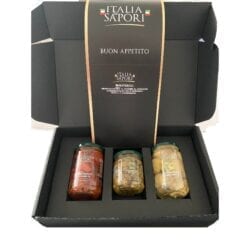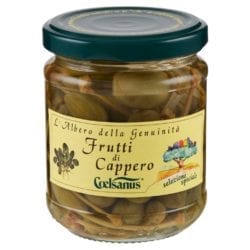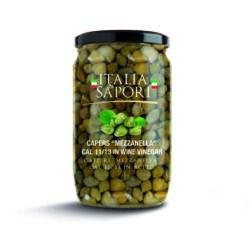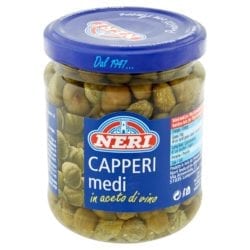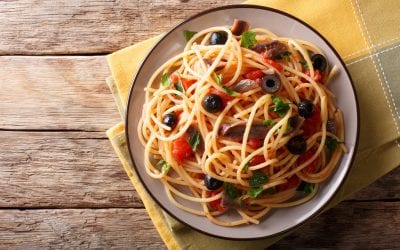Capers
Capers are the bud of a little shrub: pickled immature flower buds of the Capparis spinosa bush, Capperi’s plants are easily to recognize because of their beautiful white or pink flowers.
If the flowers are allowed to mature they became fuits of the size of olives and are filled with multiple small seeds, which grow bigger as the berry matures.
This product is a very common ingredient used in Mediterranean cuisine to enrich the flavor of fish, meat, vegetables and rice and pasta dishes.
Italian Capers are known as a good ingredient for recipes since Roman empire, especially Capers from the Aeolian Islands an archipelago of Sicily. People also believed that they had healing powers.
Buy online Capers
Discover Capers
 Capers (Capparis Spinosa) are a small shrub widespread, especially in the Mediterranean area. Usually, we consume the buds (called Capers) and also the fruits (called Cucunci). In the Italian culinary tradition they are used to flavor many typical recipes. In Italy, they grew up in many regions: Liguria, Puglia, Campania, and Sicily. The products in each region have little different characteristics. The origins, the knowledge, and the use of capers date back to very ancient times. In fact, they are mentioned by Roman authors such as Pliny. The best known Capperi variety is the Cappero from Pantelleria island, which has obtained the protected geographical indication PGI since 1993. For this small Sicilian island, they have always been a treasure, both environmental and economic, that in the past they were a real source of commercial exchange. These plants grow spontaneously on rocks or near the sea because it is typical of calcareous and steep soils. The harvest takes place between the months of June and September before there is flowering. They are hand-picked because they are too delicate to be collected mechanically.
Capers (Capparis Spinosa) are a small shrub widespread, especially in the Mediterranean area. Usually, we consume the buds (called Capers) and also the fruits (called Cucunci). In the Italian culinary tradition they are used to flavor many typical recipes. In Italy, they grew up in many regions: Liguria, Puglia, Campania, and Sicily. The products in each region have little different characteristics. The origins, the knowledge, and the use of capers date back to very ancient times. In fact, they are mentioned by Roman authors such as Pliny. The best known Capperi variety is the Cappero from Pantelleria island, which has obtained the protected geographical indication PGI since 1993. For this small Sicilian island, they have always been a treasure, both environmental and economic, that in the past they were a real source of commercial exchange. These plants grow spontaneously on rocks or near the sea because it is typical of calcareous and steep soils. The harvest takes place between the months of June and September before there is flowering. They are hand-picked because they are too delicate to be collected mechanically.
Capers: Properties and Benefits
- They stimulate the appetite and they promote the digestion
- They contain quercetin, a natural antioxidant, which has an anti-inflammatory function and anti-tumor properties and it protects the circulatory system
- They contain vitamin E which helps cells maintain their integrity, vitamins A, C, and B, and mineral salts such as iron, phosphorus, calcium, and potassium
- They strengthen the immune system
- They protect the skin from ultra-violet rays and reduce redness caused by long exposure to sunlight
- They moisturize the skin if taken regularly
- They are composed of substances that are able to fight certain types of skin allergy
- They can reduce the rate of cholesterol in the blood by bringing benefits to the cardiovascular system
- They are useful for people who have diabetic problems because they contain substances that reduce blood sugar levels and improve the functioning of the liver
- They can help weight loss thanks to their fiber content and low caloric intake
- They have anti-allergic properties, with antihistamine effects
Capers of Salina
 Salina, an island north of Sicily, in southern Italy, is considered as the center of production of capers of the highest quality that constitute the heart of the island economy. Since the beginning of the 1980s, the production of capers on the island has considerably decreased for many reasons: the arrival of North African products on the market, the impossibility of mechanizing the cultivation processes, the high cost of labor and the development of new parasites. The capers of Salina, thanks to their high quality, are characterized by compactness, fragrance, and uniformity (Source Image: Di Gomera-b ) They of Salina are an Italian Slow Food Presidium, in fact, all the manufacturers thanks to an act of promotion and collaboration, in recent years they are committed to revitalizing a product that according to tradition, island landscape and rural culture best express the connotations of this extraordinary territory. The harvest takes place between the months of May and August, every 8-10 days. The harvesters start at dawn to avoid the heat that in Southern Italy affects the summer. After harvesting, the capers are hung to dry on jute sheets, in the cool. After drying, the capers are separated from the capperoni (the larger buttons on the point of blossoming). The last process is salting: the capers are placed inside barrels made from old barrels cut in half and are alternated with a layer of coarse sea salt. In the following days the capers must be “cured”, in fact, they must be poured from one barrel to another, to avoid fermentation in the sun to ruin them. After about a month they are ready for being sell. The capers of Salina, thanks to their high quality, are characterized by compactness, fragrance, and uniformity.
Salina, an island north of Sicily, in southern Italy, is considered as the center of production of capers of the highest quality that constitute the heart of the island economy. Since the beginning of the 1980s, the production of capers on the island has considerably decreased for many reasons: the arrival of North African products on the market, the impossibility of mechanizing the cultivation processes, the high cost of labor and the development of new parasites. The capers of Salina, thanks to their high quality, are characterized by compactness, fragrance, and uniformity (Source Image: Di Gomera-b ) They of Salina are an Italian Slow Food Presidium, in fact, all the manufacturers thanks to an act of promotion and collaboration, in recent years they are committed to revitalizing a product that according to tradition, island landscape and rural culture best express the connotations of this extraordinary territory. The harvest takes place between the months of May and August, every 8-10 days. The harvesters start at dawn to avoid the heat that in Southern Italy affects the summer. After harvesting, the capers are hung to dry on jute sheets, in the cool. After drying, the capers are separated from the capperoni (the larger buttons on the point of blossoming). The last process is salting: the capers are placed inside barrels made from old barrels cut in half and are alternated with a layer of coarse sea salt. In the following days the capers must be “cured”, in fact, they must be poured from one barrel to another, to avoid fermentation in the sun to ruin them. After about a month they are ready for being sell. The capers of Salina, thanks to their high quality, are characterized by compactness, fragrance, and uniformity.
Capers Party
In Salina, in the province of Messina, in Sicily, the first Sunday of June is celebrated every year the Feast of the Caper, in the enchanting square of Pollara, a small town on the island of Salina. During the festival many local volunteers cook caper-based dishes to offer to the many visitors, it is a special occasion to taste the delicious capers of Salina, but also to savor the particular atmosphere of this paradise with a typical music frame and a breathtaking view.
Capers of Pantelleria
 The Capers of Pantelleria PGI differ from other species for branches without thorns. They have always been a real treasure for the island, so much so that it was mentioned since ancient times by numerous scholars and historians who exalted the typicality and quality of the product, able to be born and grow on stony soils and little productive or on the cliffs overlooking the sea. Source Image: Michael Leithold ) The caper, on the whole island, grows freely and spontaneously thanks to two elements: the wind and the lizards, which carry the seeds on cracks or walls, just like the wind. Since 1800 the taste and smell of the Cappero di Pantelleria is recognized excellence, so much so that the term “caper” was associated with the term “Pantelleria”, thanks also to the important sea trade of these small shrubs. The caper of Pantelleria is known since ancient times, for its strong taste, its unmistakable scent but also for its aphrodisiac virtues. Even the first reference to the belief that they were aphrodisiacs was done in the Bible, in Ecclesiastes XII, 5. The historian Carlo Volontè in his “Recipes Practices” wrote that it is Italy that boasts the best capers in the world.
The Capers of Pantelleria PGI differ from other species for branches without thorns. They have always been a real treasure for the island, so much so that it was mentioned since ancient times by numerous scholars and historians who exalted the typicality and quality of the product, able to be born and grow on stony soils and little productive or on the cliffs overlooking the sea. Source Image: Michael Leithold ) The caper, on the whole island, grows freely and spontaneously thanks to two elements: the wind and the lizards, which carry the seeds on cracks or walls, just like the wind. Since 1800 the taste and smell of the Cappero di Pantelleria is recognized excellence, so much so that the term “caper” was associated with the term “Pantelleria”, thanks also to the important sea trade of these small shrubs. The caper of Pantelleria is known since ancient times, for its strong taste, its unmistakable scent but also for its aphrodisiac virtues. Even the first reference to the belief that they were aphrodisiacs was done in the Bible, in Ecclesiastes XII, 5. The historian Carlo Volontè in his “Recipes Practices” wrote that it is Italy that boasts the best capers in the world.
How to desalinate capers
Capers can be preserved in oil, in vinegar, but the most common type of preservation is that under salt. Before consuming the capers in salt it is absolutely necessary to remove the excess salt, washing the product under running water or leave them in a bowl with cold water for about an hour. If capers are contained in a bag, just pour them with salt in a glass jar and close the cap, so that they do not lose moisture, drying out. With this method capers can last even years, maintaining their organoleptic characteristics.
How to use Capers
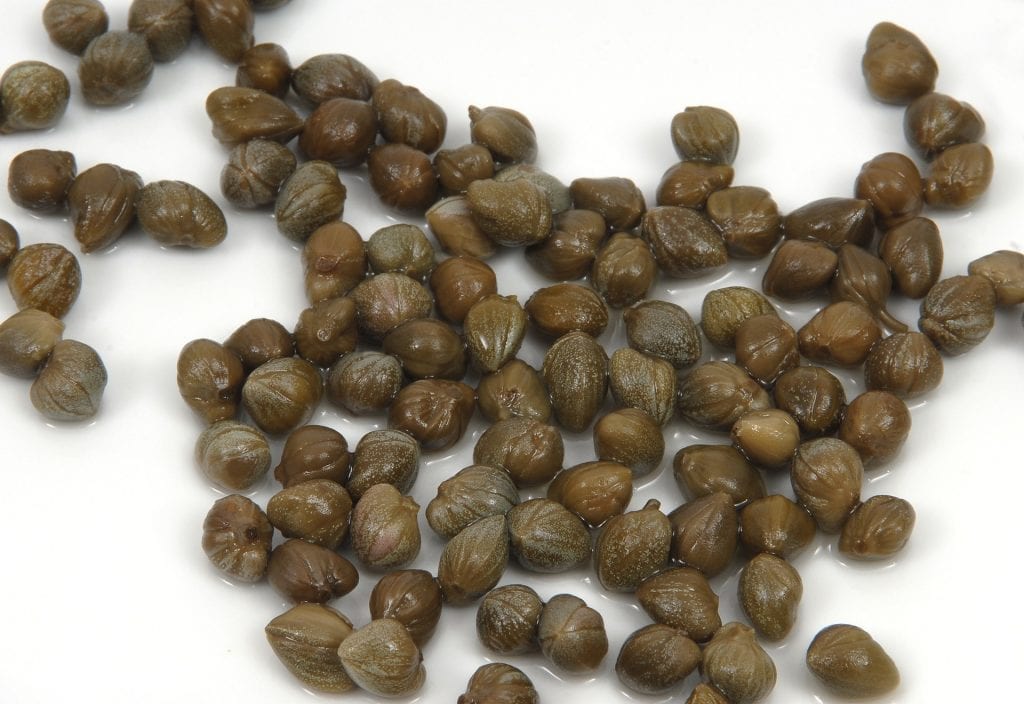 Capers are excellent ingredients of many Italian typical dishes. They can be combined with pasta, meat, and fish. They are the protagonist in Neapolitan and Sicilian pizza, in the preparation of “spaghetti alla puttanesca”, green sauce and pesto “pantesco” (mixed with tomatoes, oregano, anchovies and black olives). People from Sicily are used to prepare fried capers and add them to a potatoes salad. They also mixed capers with fresh mints, almonds, and pecorino, to create a sauce for dress pasta dishes.
Capers are excellent ingredients of many Italian typical dishes. They can be combined with pasta, meat, and fish. They are the protagonist in Neapolitan and Sicilian pizza, in the preparation of “spaghetti alla puttanesca”, green sauce and pesto “pantesco” (mixed with tomatoes, oregano, anchovies and black olives). People from Sicily are used to prepare fried capers and add them to a potatoes salad. They also mixed capers with fresh mints, almonds, and pecorino, to create a sauce for dress pasta dishes.
Recipes & News
Capers – a New PDO in Sicily
May 2020, there has been the creation of the new PDO Aeolian Capers. The production of this new PDO currently stands at 600-700 quintals a year and about half comes from Salina.
The Cultivation of Capers
The cultivation of capers has ancient origins: it was born between North Africa and the Middle East and there are traces of it in the Bible, but also in the writings of Hippocrates, Aristotle and Pliny the Elder. Photo Credit: Wikipedia It is a resistant plant, able...
Capers on the ancient Roman Aurelian walls
Caper is a wild plant, stunning and amazingly fragranced. Did you know Italian capers used to grow on the Roman Aurelian walls and still do? These walls are almost 13k long, have protected “the eternal city” for centuries
How to desalinate capers
Capers are usually preserved in salt, so, before being consumed, they must be subjected to a procedure known as “Desalting”
Sicilian Swordfish
Sicilian Swordfish is a typical dish of the culinary tradition of the city of Messina, in southern Italy. It is a simple, genuine recipe, prepared with typical Sicilian ingredients: swordfish, cherry tomatoes, olives and capers. Ingredients: 300...
Vitello Tonnato
Vitello Tonnato is a typical dish of Piedmontese cuisine, handed down from generation to generation. It is actually very easy and fast, but above all, thanks to the tuna and egg sauce and really tasty.
Spaghetti alla Puttanesca
Spaghetti Alla Puttanesca are a typical dish of the regions of Campania and Lazio, in southern Italy. Just a few minutes to prepare them and to get a really tasty result, with a touch of spicy given by the fresh chili.

